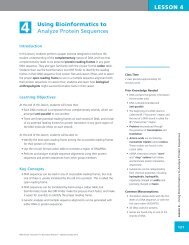WET LAB DNA Barcoding: From Samples to Sequences - Northwest ...
WET LAB DNA Barcoding: From Samples to Sequences - Northwest ...
WET LAB DNA Barcoding: From Samples to Sequences - Northwest ...
Create successful ePaper yourself
Turn your PDF publications into a flip-book with our unique Google optimized e-Paper software.
<strong>WET</strong> <strong>LAB</strong><br />
CLASS SET<br />
11. To prepare your <strong>DNA</strong> (PCR) sample for<br />
the gel (see Figure 3.3):<br />
a. Label a new 1.7 ml microfuge tube<br />
with your name and the word “gel.”<br />
b. Add 5.0 μl of 3X loading dye<br />
(labeled “3X”) <strong>to</strong> your new “gel”<br />
microfuge tube.<br />
c. Add 10.0 μl of your PCR sample <strong>to</strong><br />
your “gel” microfuge tube.<br />
Transfer Transfer your your 50 50 µl µl PCR PCR <strong>to</strong> <br />
<strong>to</strong> new a New Microfuge Tube Tube <br />
Labeled with Your Name<br />
and “PCR” <br />
PCR <br />
Transfer your 10 µl 10 of µl your of your PCR <br />
PCR <strong>to</strong> <strong>to</strong> a New new Microfuge Tube <br />
Labeled with Your Name<br />
and “Gel” <br />
Figure 3.3: Transferring Your PCR Reaction <strong>to</strong> Microfuge Tubes.<br />
Gel <br />
12. Have a member of your group prepare the PCR Negative Control (tube “0”) for the gel:<br />
a. Label another new 1.7 ml microfuge tube with your group’s name, “negative control,” and “gel.”<br />
b. Add 5.0 μl of 3X loading dye (labeled “3X”) <strong>to</strong> the negative control “gel” microfuge tube.<br />
c. Add 10.0 μl of the negative control PCR sample “0” <strong>to</strong> the negative control “gel” microfuge tube.<br />
13. Cap the “gel” microfuge tubes, and mix them by either flicking the tube with your finger and tapping the<br />
tube on your bench <strong>to</strong>p, or by vortexing and then spinning the tubes in a microcentrifuge.<br />
14. In your lab notebook or on a separate sheet of paper, make a table similar <strong>to</strong> Table 3.1 <strong>to</strong> list where you<br />
will load each sample from your group on your <strong>DNA</strong> gel. You will also be loading molecular weight standards<br />
on each gel. Molecular weight standards (sometimes abbreviated “MW”) contain pieces of <strong>DNA</strong> of known<br />
sizes (see Figure 3.5 at the end of this handout). This will help you determine whether your PCR reactions<br />
produce <strong>DNA</strong> bands of the expected size (about 650 base pairs). Be sure <strong>to</strong> include your molecular weight<br />
standards in your table and on your gel!<br />
[Note: The Well Number is the slot on the<br />
gel in which you will load your samples<br />
(see Figure 3.4). Most gels have 8 wells,<br />
but some have only 6, and others have up<br />
<strong>to</strong> 20. Check <strong>to</strong> see how many wells are<br />
in your gel.]<br />
15. Put your gel in your gel box and<br />
add enough <strong>DNA</strong> Gel Buffer <strong>to</strong> the<br />
gel box <strong>to</strong> just cover your gel.<br />
Remember: “Run Towards Red.”<br />
Be sure that the <strong>to</strong>p of your <strong>DNA</strong><br />
gel (where the wells are) is near the<br />
negative, or black, electrode on the<br />
gel box, and the bot<strong>to</strong>m of your gel<br />
is near the positive, or red, electrode.<br />
That way the negatively-charged<br />
<strong>DNA</strong> will always “run <strong>to</strong>wards red.”<br />
Well Number Sample Name<br />
1 ________________________________________<br />
2 ________________________________________<br />
3 ________________________________________<br />
4 ________________________________________<br />
5 ________________________________________<br />
6 ________________________________________<br />
7 ________________________________________<br />
8 ________________________________________<br />
Example:<br />
1 ________________________________________<br />
Molecular Weight Standard<br />
2 ________________________________________<br />
Joe Ting’s Salmon PCR-1<br />
Table 3.1: <strong>Samples</strong> Loaded on<strong>to</strong> <strong>DNA</strong> Gel<br />
Wet Lab – <strong>DNA</strong> <strong>Barcoding</strong>: <strong>From</strong> <strong>Samples</strong> <strong>to</strong> <strong>Sequences</strong><br />
361<br />
©<strong>Northwest</strong> Association for Biomedical Research—Updated Oc<strong>to</strong>ber 2012
















